StemUp: OCR A A level Physics 5.4: Gravitational fields
1/42
There's no tags or description
Looks like no tags are added yet.
Name | Mastery | Learn | Test | Matching | Spaced |
|---|
No study sessions yet.
43 Terms
What is a force field? (1)
This is an area where an object will experience some force if placed inside it.
How are gravitational fields caused? (1)
Any object with mass has a gravitational field, extending to infinity.
What happens inside a gravitational field? (1)
An object placed in a gravitational field will experience an attractive force towards the centre of mass of the object.
How does the strength of a gravitational field change with distance? (1)
As the distance from the centre of mass increases, the gravitational field strength decreases until it becomes zero at infinite distance.
How can a spherical object be modelled? (1)
Objects with mass can be modelled as a spherical point mass where the point is where the centre of mass of the object is.
What are gravitational field lines? (1)
These are arrows that show the direction of gravitational force that an object will experience in a field.
How do field lines show the strength of the force? (1)
If the lines are closer together, the force is stronger.
What is a radial gravitational field and what does it look like? (2)
This is a field where the straight field lines converge at the centre of mass. They point to the centre of mass to show gravity is an attractive force. It looks like:
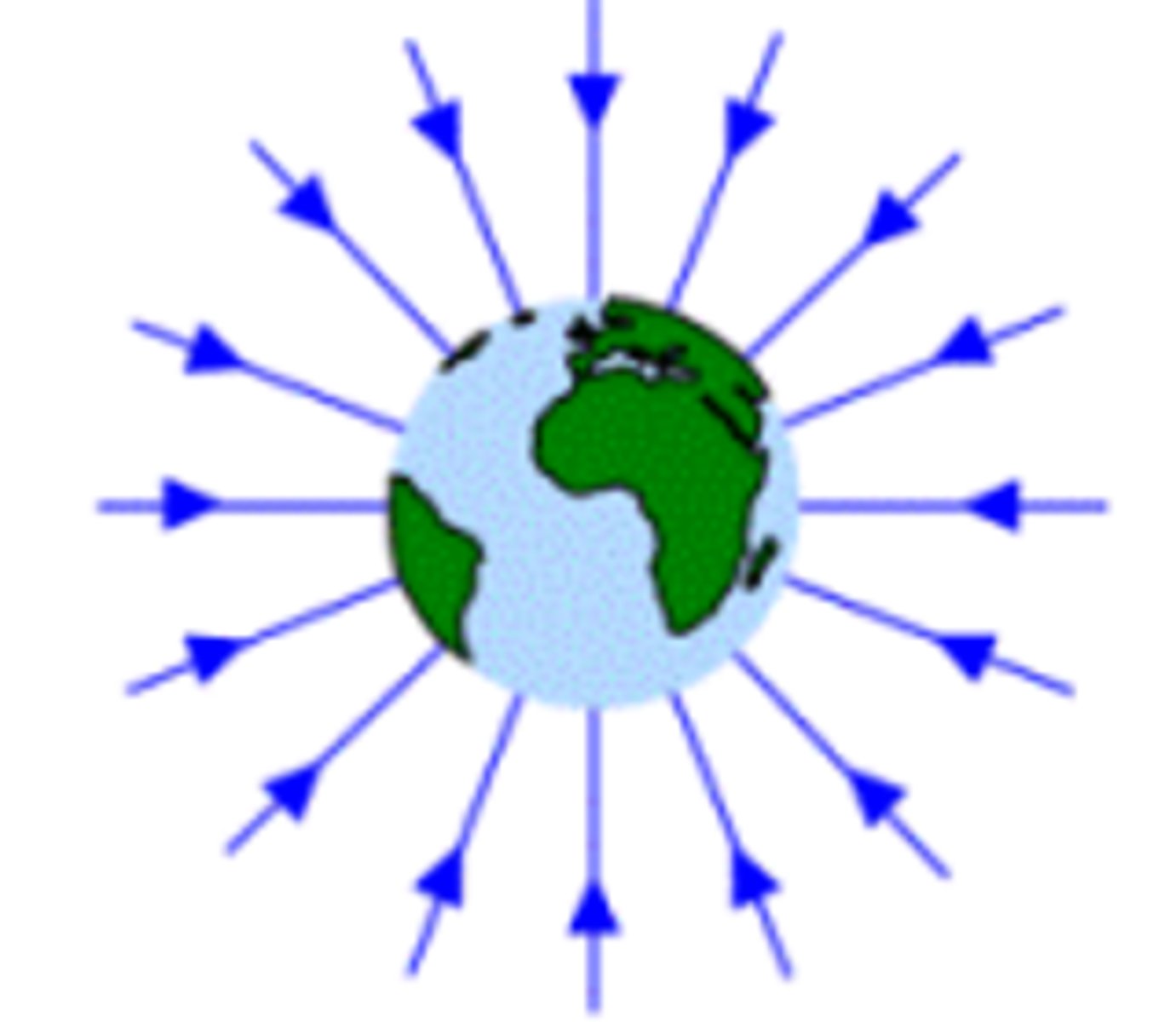
What is a uniform gravitational field and what does it look like? (2)
This is where the field strength is equal at all positions so the field lines are parallel and spaced equally. This can be used to model gravitational fields on a small scale such as the Earth's surface. It looks like:
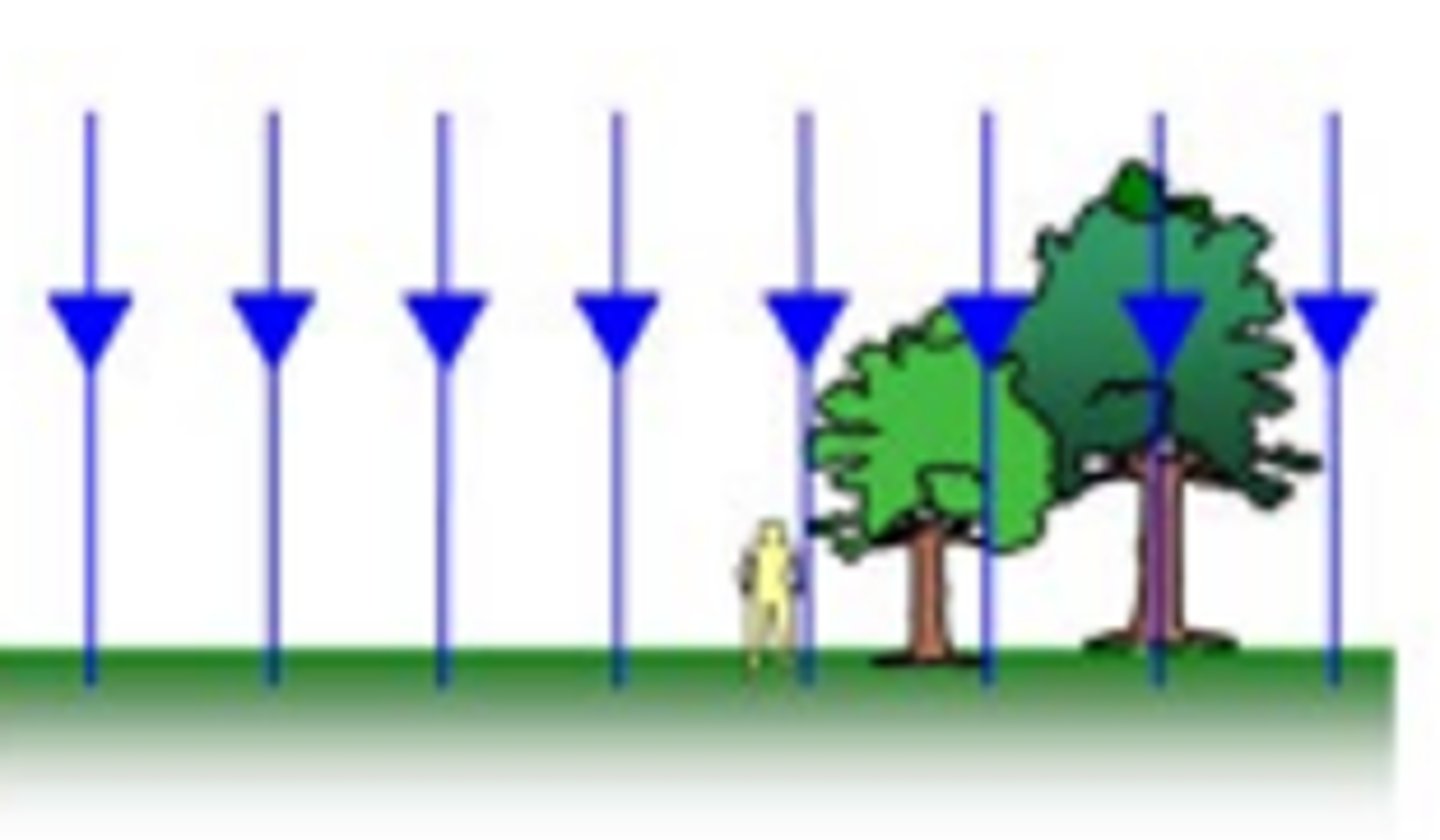
What is meant by the gravitational field strength? (1)
This is a vector quantity which is defined as the gravitational force experienced per unit mass at a point in a gravitational field. Measured in Nkg^-1 or ms^-2
What is the equation for gravitational field strength (g)? (1)
This is given by: g = F / m where F is the gravitational force (N) and m is the mass of the object (kg).
What are the units for gravitational field strength? (1)
It is measured in Nkg^-1 or ms^-2
When is the equation for gravitational field strength valid? (1)
The equation g = F / m is only valid if the objects gravitational field is negligble compared to the external gravitational field it is inside.
What does Newton's law of gravitation state? (1)
This states that two point masses attract each other with a force that is directly proportional to the product of their masses, and inversely proportional to the square of their separation.
What is the equation for Newton's law of gravitation? (2)
The gravitational force (F) between two point masses is: F = -GMm / r^2
Where G is the gravitational constant (6.67 x 10^-11 Nm^2kg^-2) M is the mass of the larger point mass (kg), m is the mass of the smaller point mass (kg) and r is the separation of the centres of the objects (m).
What does the negative sign in the equation for Newton's law of gravitation show? (1)
The negative sign in F = -GMm / r^2 shows the attractive nature of the force of gravity.
What is the gravitational constant (G)? (1)
This is given by 6.67 x 10^-11 Nm^2kg^-2
How is the gravitational field strength for a point mass found? (2)
- As the gravitational field strength is given by g = F / m and F = -GMm / r^2
- These equations can be combined to find g = GM / r^2 which shows that the field strength only depends on the mass of the larger object, not the smaller object being attracted to it.
What does the gravitational field strength equation for a point mass show? (1)
g = GM / r^2 shows that the field strength only depends on the mass of the larger object, not the smaller object being attracted to it.
How can the gravitational field strength be modelled near the Earths surface? (1)
The gravitational field can be modelled as uniform and it has the same value as the acceleration of free fall (9.81).
What is Kepler's first law? (1)
Kepler's first law states the orbit of a planet is an ellipse, with the sun at one focus.
What is Kepler's second law? (1)
Kepler's second law states a line segment joining a planet and the sun sweeps out equal areas during intervals of equal time.
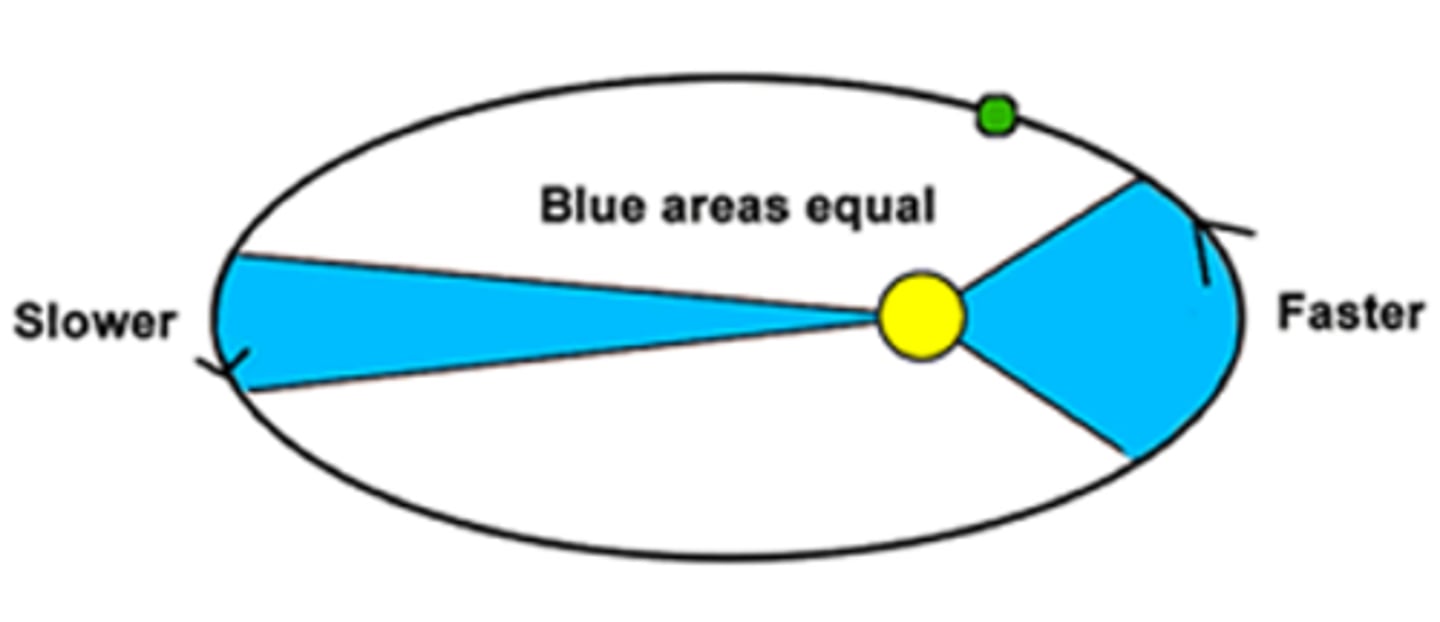
What is Kepler's third law? (1)
Kepler's third law states the square of the orbital period (T) is proportional to the cube of the distance (r) from the sun.
What is the centripetal force on a planet provided by? (1)
The centripetal force is provided by the gravitational force between the planet and the sun.
What is the equation for Kepler's third law? (1)
The equation is T^2 = 4π^2 r^3 / GM
Where T is the time period for the object to complete one orbit (s). r is the distance between the object and the larger object it is orbiting (m). G is the gravitational constant (6.67 x 10^-11 Nm^2kg^-2 and M is the mass of the larger object being orbited (kg).
How is the equation for Kepler's third law derived? (3)
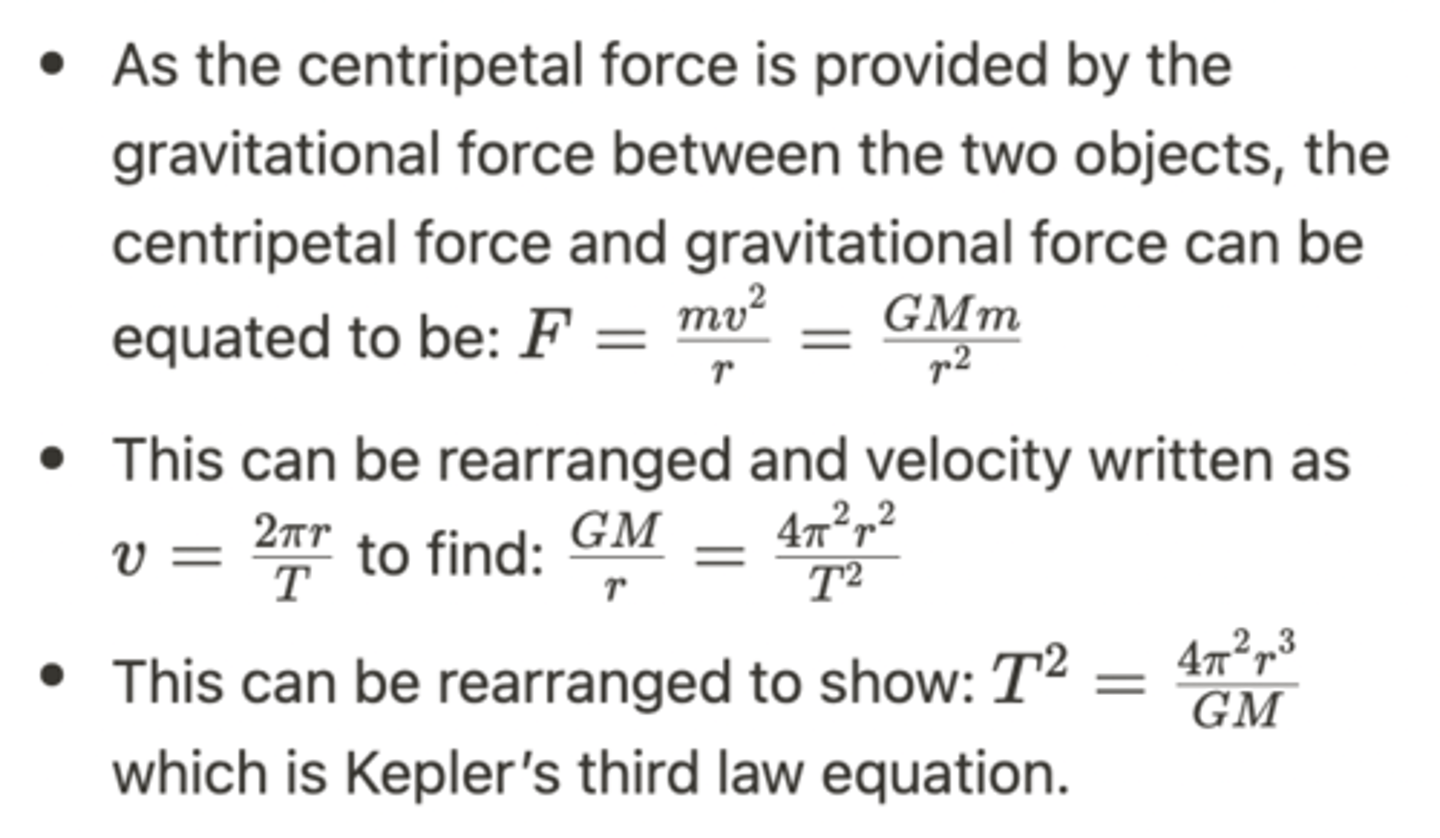
What situations can the equation for Kepler's third law be used in? (2)
- This can be used to model orbits for planets orbiting the sun in our solar system and other solar systems.
- It can also be used to model orbiting satellites around the Earth.
What is meant by a satellite? (1)
A satellite is an object that orbits a larger object. This can mean natural satellites (e.g the moon that orbits the earth) or an artificial satellite (e.g a GPS satellite orbiting the Earth).
What is meant by a geostationary orbit? (2)
This is an orbit which has an orbital period of 1 day (24 hours), objects with this orbit travel in the same direction as the rotation of the Earth (along the equator) and remain in the same position above the sky.
What is meant by a geostationary satellite? (1)
This is a satellite which has a geostationary orbit.
What are the uses of geostationary satellites? (1)
As they stay above the same point of the Earth's surface, they are useful for communications and surveying as they provide continuous coverage.
What is meant by gravitational potential? (2)
- Gravitational potential is defined as the work done per unit mass to move an object to that point in the gravitational field from infinity.
- It is measured in Jkg^-1
What is the value of the gravitational potential at infinity? (1)
As the gravitational field at infinity is negligible, the gravitational potential is equal to 0.
What is the equation for gravitational potential at a given point? (1)
This is given by: V_g = -GM / r
Where V_g is the gravitational potential (Jkg^-1), M is the mass the object is being moved away from (kg) and r is the distance between the two objects at a given point (m).
What is meant by gravitational potential energy? (1)
This is the work done to move an object with mass from infinity to a point in that field. Measured in Joules (J).
What is the equation for gravitational potential energy at a given point? (2)
This is just the mass multiplied by the gravitational potential at the given point: E_g = -GMm / r
Where E_g is the gravitational potential energy (J), M is the mass the object is being moved towards (kg), m is the mass of the object that is moving (kg) and r is the distance between the two objects at a given point (m).
What does a force-distance graph from a spherical mass/point mass look like? (1)
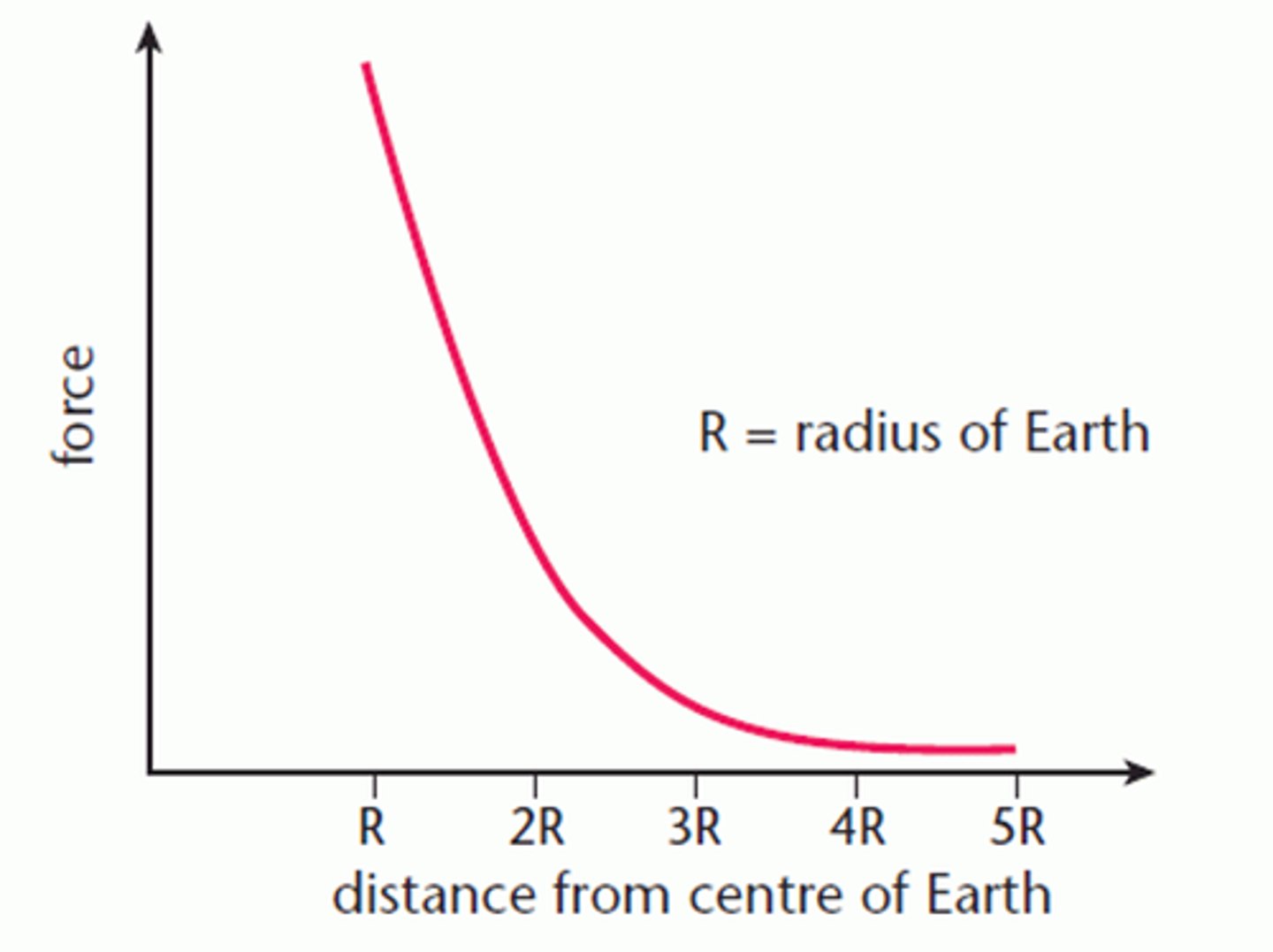
What does a force-distance graph from a spherical mass/point mass show? (2)
- The area under the graph is equal to the work done in moving an object between these points.
- The force at the surface of the earth is the strongest and it decreases quadratically further away from the surface.
How is the work done found from a force-distance graph? (1)
This is equal to the area under the force-distance graph.
What is meant by the escape velocity? (1)
This is the velocity needed for an object to escape a larger object's gravitational field.
What is the condition for an object to reach the escape velocity? (1)
The kinetic energy of the object must be equal to or greater than the gravitational potential energy required to lift it to infinity.
What is the equation for escape velocity (v)? (1)
This is: v = √2GM / r
Where v is the escape velocity (ms^-1), G is the gravitational constant (6.67 x 10^-11 Nm^2kg^-2), M is the mass of the larger object (kg) and r is the radius of the larger object (m).
How is the equation for escape velocity derived? (2)
- This is done by equating the kinetic energy to the gravitational potential energy required to lift it to infinity. 1 / 2 mv² = GMm / r
- This is rearranged to find the escape velocity: v = √2GM / r